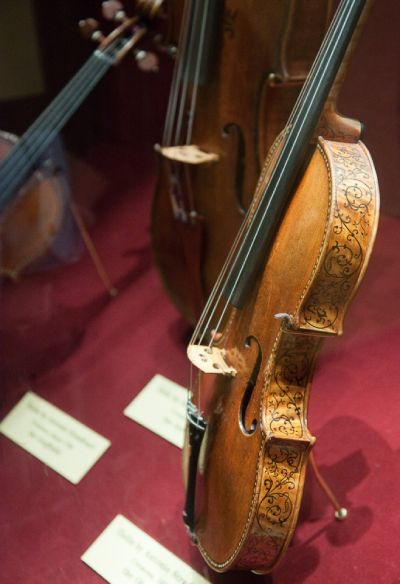Ole Bornemann Bull (Bergen, 5 February 1810 – Lysøen, 17 August 1880) was a Norwegian violinist and composer. Ole Bull holds a special place in Norwegian history for his proud fight for political freedom, Norway’s independence from Sweden and national culture; Edvard Grieg called him a “pioneer for our young national music.”
Considered one of the greatest Romantic performers on par with Chopin and Liszt, he wrote two concertos and many brilliant pieces for violin. For his virtuosity, he was called “the Paganini of the North”.
He was admitted to play in Bergen’s ” Armonie ” orchestra at only eight years old, while at thirteen he could perform all of Paganini’s Caprices. Later he left his theological studies already under way at the University of Christiania to devote himself to a career in music. In 1828 in Oslo he was appointed director of the city’s musical societies, “The Musical Lyceum” and the theater orchestra, while in 1829 he went to Kassel to see and hear violinist Louis Spohr. In 1831 he went to Paris, where he met Paganini and studied with one of his students, Heinrich Wilhelm Ernst. He made his Paris debut in 1832, thanks to the influence of Chopin and Ernst himself. Bull made his first tour of Switzerland and Italy in 1833; he learned from a tenor how to make the violin “sing” and developed the technique of playing on the four strings simultaneously to imitate organ harmonies. He was also a true master of improvising on themes given by the audience.
He made his debut as a virtuoso in Bologna in April 1834, fortuitously, having to replace at the last moment the famous singer Maria Malibran who was indisposed. From that date success came his way. A skillful propagandist of himself, in Italian concerts he invited and even paid people to applaud. Returning to Paris at the age of twenty-five, he paid a journalist to write a short biography of him and hired a secretary to organize the concerts. In Italy he had his portraits and small busts made in series, to be sold as propaganda in music stores.
The press painted a modest young man almost at the antipodes to Paganini, who apparently was so stingy that he played with a mute so that no one could hear him without having to pay. Ole Bull often played for charity, for victims of fire or war. He was very proud; in Italy he refused to play because a lady-in-waiting to the queen was chattering. In St. Petersburg he refused to play while the tsar was waiting. In the presence of King Carl Johan of Sweden he was insulted because the king told the tsar that he too had Poles in his kingdom: the Norwegians.
Glorified or called a charlatan, his career became unstoppable with ticket prices triple the normal because everyone wanted to hear him. From 1834 until 1880 he gave uninterrupted concert tours around the world at a breakneck pace, while Paganini and Franz Liszt gave tours for ten and fifteen years respectively. In 1836, for example, he gave two hundred forty-seven concerts in England alone. In Germany in 1838 he had a special carriage built so that he could travel immediately after a concert, waking up in another city to rehearse immediately with the orchestra. Sometimes he would perform twice in the same day. Thanks to his steely physique, kept in training with ante litteram naturist conducting, he sustained tours for about fifty years, touring the world in the most diverse weather conditions, from Cuba to St. Petersburg, from Cairo and Algiers to almost all of America, as well as Europe, of course.
Speaking of the relationship between Liszt and Bull, their quarrel that occurred in Budapest is famous:
“They were playing the Kreutzer Sonata together in a private hall in Budapest; taking advantage of a break, Bull shouted irritably at Liszt: ‘With you it is impossible to play… You do not keep time and insist on playing out of the way.’ Liszt retorted furiously, “You old buffoon, you dare say such a thing to me, Franz Liszt!” The diatribe degenerated into an altercation and ended on this invective from Liszt: “When your name is forgotten, the world will still kneel to my memory.” The next day Bull gave a concert, which was not a great success, among other things from the point of view of rhythm. In the front row seats, Liszt clapped his hands ostentatiously, but whispered to his neighbor, ‘And he wanted to give me piano lessons, this old nag.'”
From Jean Baptiste Vuillaume he learned the art of luthier becoming very skilled. He built a special bow, slightly longer than the modern bow; he experimented with varnishes to improve the sound. He bought and resold like a true merchant dozens of historic violins, by Nicola Amati, Giuseppe Guarneri, Antonio Stradivari, Giovanni Paolo Maggini, Gasparo da Salò, Matteo Benti, Santo Serafin, Claude Miremont, and Antonio Mariani. He played almost exclusively on Guarneri del Gesù, Gasparo da Salò, and a Nicola Amati large measure; he did not favor Stradivarius, though he owned them he almost always sold them. His two favorite violins for 40 years of world tours inflamed as rhythms and level of performance were a Guarneri del Gesù and the Gasparo da Salò that belonged to the imperial collections of the Habsburgs, with richly carved heads sprinkled with precious stones, seen in Vienna by a collector named Rehaczec and then purchased by him in 1841.
In 1851 he founded Norway’s first drama theater in Bergen. In the United States he built a new type of grand piano based on the principles of violin construction. He even obtained a patent for such an instrument and produced a few examples, but they did not meet with much success.
Ole Bull’s residence in Lysøen

In 1872 Ole Bull bought the island of Lysøen in Os, south of Bergen, and hired architect Conrad Fredrik von der Lippe to design and build a residence on the island, now owned by the Society for the Preservation of Norwegian Monuments.
He died of cancer at the Lysøen mansion on August 17, 1880. Not long before, despite his illness, he had given his last concert in Chicago. His funeral procession was in very pompous style, reflecting the great fame he had acquired over the years and the affection of Norwegians: his coffin was carried by a ship escorted by 15 others and a large number of smaller boats.
Ole Bull holds a special place in Norwegian history for his proud fight for political freedom, Norway’s independence from Sweden and national culture; Edvard Grieg called him a “pioneer for our young national music.”
